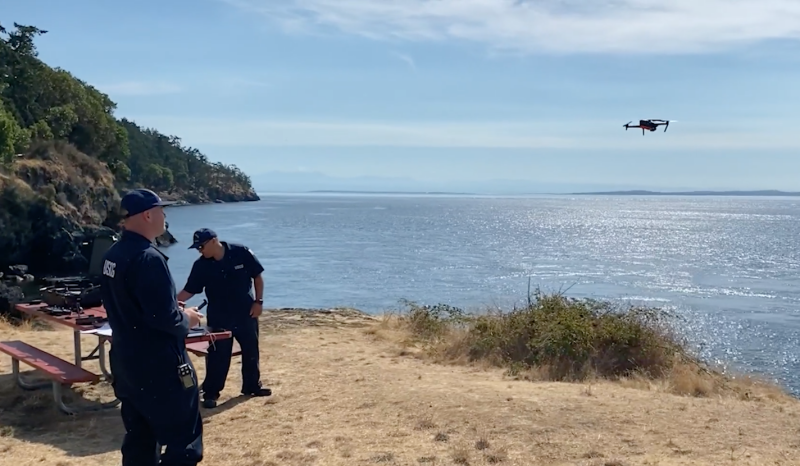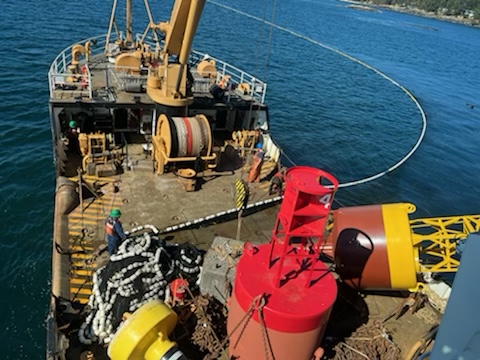Two weeks after a fishing vessel sank near San Juan Island in Washington state, a pollution response effort is now focused on raising the wreck from 200-foot depths to recover its slowly leaking oil.
The 49-foot Aleutian Isle took on water and sank around 2 p.m. Aug. 13. An unidentified good Samaritan vessel took the five crew members off safely, as the Coast Guard launched a helicopter from Air Station Port Angeles, a 45-foot response boat from Bellingham, and the 87-foot cutter Swordfish to the scene.
The cause of the sinking is under investigation.
The Aleutian Isle was carrying an estimated 2,500 gallons of diesel fuel and 100 gallons of hydraulic fluid when it went down near Sunset Point on the west side of San Juan Island. With the boat’s crew accounted for, the Coast Guard shifted into a pollution response effort. Three hours after the sinking, Coast Guard crews reported a visible oil sheen two miles long and potentially drifting toward Canadian waters.
The immediate response group was assembled including the San Juan County Office of Emergency Management, Washington State Department of Ecology, Island Oil Spill Association and other wildlife and conservation groups. Experts at the National Oceanic and Atmospheric Administration contributed a “resources at risk assessment” and a spill trajectory analysis to anticipate where pollution might drift.
Responders were especially concerned with protected marine mammals in the region, including the highly endangered Puget Sound Southern Regional killer whale population. Coast Guard crews, NOAA personnel, and members of The Whale Museum and Sound Watch remained on scene throughout the night utilizing underwater hydrophone acoustics to monitor the affected area and surrounding waters for any whale activity.
Some killer whales were near the southern tip of San Juan Island at the time, but none in the affected area around the wreck, the Coast Guard said.
Two days after the sinking, crews were using absorbent booming to capture small amounts of oil that continued to vent from the sunken Aleutian Isle. Cleanup surveys around nearby shorelines found minimal impact from oil. However, commercial divers and salvors working on the recovery effort found the wreck had shifted into deeper water around 200 feet down.
The Coast Guard and its unified command of partners have intently focused on the potential environmental impact to the San Juan Island region if a major spill were to occur.
With the depth of the wreck posing a challenge to divers, a remote operated vehicle was used Aug. 17 to confirm the vessel was upright and its fuel tanks intact, according to an ongoing online narrative by the Washington state Department of Ecology.
Net floating from the wreck posed a potential hazard for wildlife, and the Coast Guard buoy tender Henry Blake was on scene to assist Aug. 17.
The Henry Blake crew “recovered more netting, weighing 400 pounds, that was lifted by crane out of the water. Approximately 1,400 feet of netting have been recovered by the crew of the Henry Blake and dive crews over the past two days,” according to a statement from the Department of Ecology. “Five dogfish were found entangled in one net, one of which was successfully released. No other animals were found entangled.”
Diving on the wreck 200 feet down is difficult and dangerous. Divers must use specialized breathing gas mixtures at such depths. On top of that, “divers face the strong currents of Haro Strait,” according to state ecology officials. “The dive teams must wait for the apex of either high tide or low tide, also known as ‘slack tide,’ before entering the water.”
Early this week a barge and crane were on the way from Seattle to raise the Aleutian Isle. Monitoring is ongoing and Coast Guard crews are even using drones to watch for any new appearance of oil.
“Daily overflights have shown the amount of sheening remains minimal,” according to state officials. “Crews have added additional absorbent boom to ensure environmentally sensitive areas are protected in case any sheening moves closer to land.”








